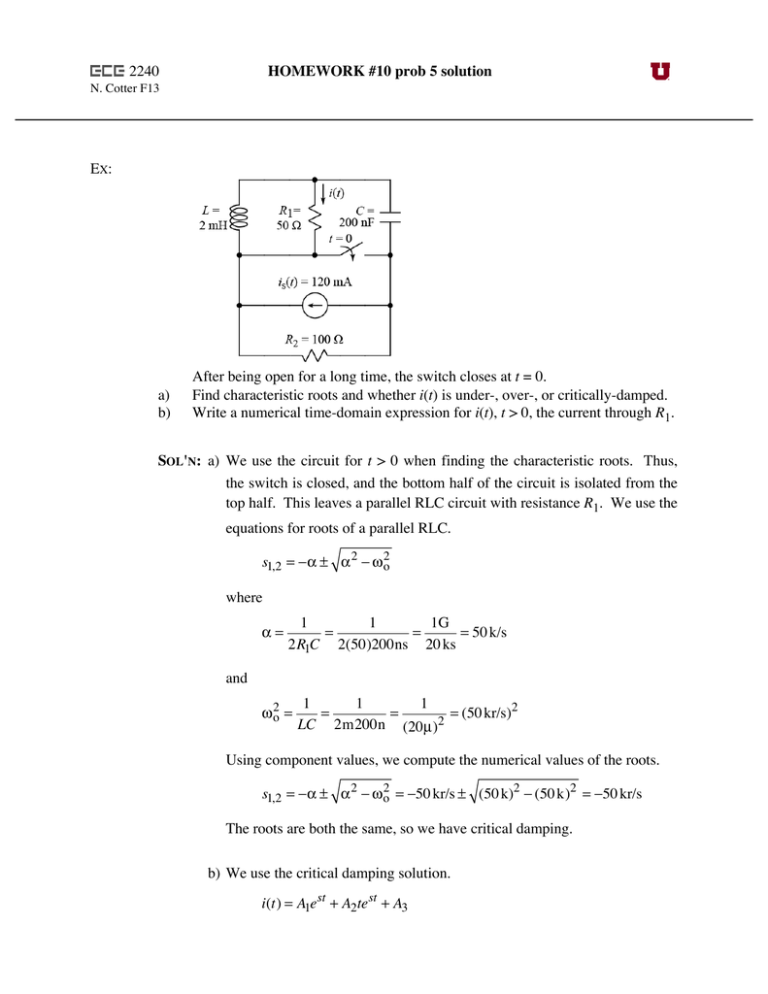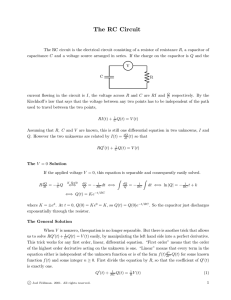2240 HOMEWORK #10 prob 5 solution EX: After being open for a
advertisement

HOMEWORK #10 prob 5 solution 2240 N. Cotter F13 EX: a) b) After being open for a long time, the switch closes at t = 0. Find characteristic roots and whether i(t) is under-, over-, or critically-damped. Write a numerical time-domain expression for i(t), t > 0, the current through R1. SOL'N: a) We use the circuit for t > 0 when finding the characteristic roots. Thus, the switch is closed, and the bottom half of the circuit is isolated from the top half. This leaves a parallel RLC circuit with resistance R1. We use the equations for roots of a parallel RLC. s1,2 = −α ± α 2 − ω o2 where α= 1 1 1G = = = 50 k/s 2R1C 2(50)200ns 20 ks and ω o2 = 1 1 1 = = = (50 kr/s)2 2 LC 2m200n (20µ) Using component values, we compute the numerical values of the roots. s1,2 = −α ± α 2 − ω o2 = −50 kr/s ± (50 k)2 − (50 k)2 = −50 kr/s The roots are both the same, so we have critical damping. b) We use the critical damping solution. i(t) = A1e st + A2te st + A3 The value of A3 is the final value of i(t), which is found by assuming the circuit has stabilized and C = open, L = wire. The switch is closed as t approaches infinity, so the bottom half of the circuit is irrelevant and we have no power source in the top half. Thus, the cirucit will run down to zero. This causes the final value to be zero. A3 = 0 A Now we find initial conditions so we can solve for A1 and A2. We consider t = 0–. The switch is open, and the C acts like an open and the L acts like a wire. We find vC and iL. Because of the open circuits, no current can flow in the L, so iL = 0 A. As indicated by the arrows in the above diagram, the voltage drop across C is the same as the voltage drop across R2, which is isR2. vC (0 − ) = is R2 = 120 mA ⋅100! = 12 V We use the initial values for the L and C as the values of sources in the model at t = 0+. Since the voltage of the capacitor is directly across R1, we use Ohm's law to find the initial value of i(0+). i(0 + ) = 12 V = 240 mA 50! We match this value to the value our symbolic solution gives at time 0+. i(0 + ) = A1 = 240 mA To find A2, we use the derivative of i(t) at t = 0+. To find the value of the derivative of i(t) at t = 0+, we first write i(t) in terms of energy variables iL and vC. Since R1 is across vC, we just use Ohm's law again. v (t) i(t) = C R1 Now we differentiate the equation. di(t) 1 dvC = dt R1 dt We can now substitute for the derivative of the capacitor voltage by using the component equation for the capacitor. (This is why we wrote i(t) in terms of energy variables.) dvC iC = dt C so di(t) 1 iC = dt R1 C Now we evaluate the derivative at time 0+. di(t) 1 iC (0 + ) = dt t=0 + R1 C Since the L carries no current at t = 0+, the current in R1 must be supplied by the C. The current flows up from the C and down through R1. The direction of the current is opposite the passive sign convention, so it is the negative of the current in R1. iC (0 + ) = −240 mA Now we can compute the value of the derivative of i(t) at time 0+. di(t) 1 −240 mA 240 m = =− = −24 kA/s dt t=0 + 50 Ω 200 nF 10 kn We match the derivative of our symbolic solution to this value. A1s + A2 = −24 kA/s or 240 mA ⋅(−50 k/s) + A2 = −24 kA/s or A2 = −24 kA/s − (240 mA)(−50 k/s) = −12 kA/s We have our answer. i(t) = 240mA e −50k t −12kA/st e −50k t

